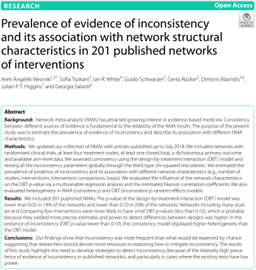Fil d'Ariane
Documents et Média
Prevalence of evidence of inconsistency and its association with network structural characteristics in 201 published networks of interventions
Prevalence of evidence of inconsistency and its association with network structural characteristics in 201 published networks of interventions
Version 1.1 Approuvé
- Type de document
- EXTERNAL_DOCUMENT
- Extension
- png
- Taille
- 85 Ko
- Modifié
- 21/10/22 13:25 par mir mir
- Créé(e)
- 21/10/22 13:24 par mir mir
- Localisation
- PUBLIC
- Notations
-
-
Version 1.1Par mir mir, sur 21/10/22 13:25Log Pas de changement
-
Version 1.0Par mir mir, sur 21/10/22 13:24Log Pas de changement
Résumé
Background
Network meta-analysis (NMA) has attracted growing interest in evidence-based medicine. Consistency between different sources of evidence is fundamental to the reliability of the NMA results. The purpose of the present study was to estimate the prevalence of evidence of inconsistency and describe its association with different NMA characteristics.
Methods
We updated our collection of NMAs with articles published up to July 2018. We included networks with randomised clinical trials, at least four treatment nodes, at least one closed loop, a dichotomous primary outcome, and available arm-level data. We assessed consistency using the design-by-treatment interaction (DBT) model and testing all the inconsistency parameters globally through the Wald-type chi-squared test statistic. We estimated the prevalence of evidence of inconsistency and its association with different network characteristics (e.g., number of studies, interventions, intervention comparisons, loops). We evaluated the influence of the network characteristics on the DBT p-value via a multivariable regression analysis and the estimated Pearson correlation coefficients. We also evaluated heterogeneity in NMA (consistency) and DBT (inconsistency) random-effects models.
Results
We included 201 published NMAs. The p-value of the design-by-treatment interaction (DBT) model was lower than 0.05 in 14% of the networks and lower than 0.10 in 20% of the networks. Networks including many studies and comparing few interventions were more likely to have small DBT p-values (less than 0.10), which is probably because they yielded more precise estimates and power to detect differences between designs was higher. In the presence of inconsistency (DBT p-value lower than 0.10), the consistency model displayed higher heterogeneity than the DBT model.
Conclusions
Our findings show that inconsistency was more frequent than what would be expected by chance, suggesting that researchers should devote more resources to exploring how to mitigate inconsistency. The results of this study highlight the need to develop strategies to detect inconsistency (because of the relatively high prevalence of evidence of inconsistency in published networks), and particularly in cases where the existing tests have low power.

Le projet COMPAR-EU a été financé par le programme de recherche et d'innovation Horizon 2020 de l'Union européenne dans le cadre de la convention de subvention n° 754936.
Veuillez noter qu'il s'agit de la version bêta de la plateforme COMPAR-EU. Il comprend désormais les résultats complets concernant le diabète et, au cours de l'été 2022, les résultats concernant l'obésité, la BPCO ainsi que l'insuffisance cardiaque seront complétés. La plateforme sera également étendue et améliorée pendant les mois à venir.
